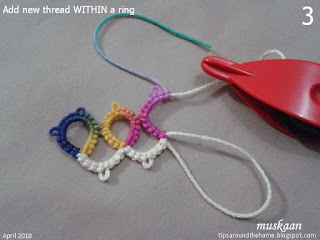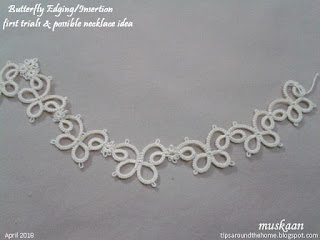And just in time, phew!!! What an exciting range of
projects to start off this month’s task of covering a cabone ring. I want to
make each and every one of them someday. It was Renata’s turn to choose this time – Summer in Circle.
This is my April submission for 'I Love Tatting' –
Royal Wave Bangle
with free pattern directions
I didn’t have any hollow ring except for my loads of now neglected bangles which are unfortunately all circular. And I wasn’t confident with a glass bangle, so went with this metallic one despite the golden knobs projecting along the circumference. They made covering it more difficult and despite my diligence, the green peeps out at places.
Turns out I’d forgotten and had to consult tutorials on
cabone tatting. This was a good refresher after my first bangle.
But this time I wanted to use 2 colours alternately as a
personal challenge. I chose thread colours to complement the lovely beads Usha sent me. These are vintage threads
and closer to a size 50 or finer than the Anchor size 40 they claim to be ;-P
TIP : The thread not in use is encapsulated/hidden within the
visible colour. The trick is simple. Keep the ‘not-in-use’ shuttle dangling and
encapsulation becomes easy. The thread tends to stay alongside the bangle.
Merely ensure that you pull the thread taut before switching colours.
I used scraps of the purple thread and had to join new
thread at least 3 times, using a simple weaver’s knot and then encapsulating
all tails within the next few stitches. This tiny knot is not visible.
Basic Pattern is simple and can be adjusted to any bangle size. I didn't have any specific pattern in mind - just let my shuttles take the lead.
Basic Pattern is simple and can be adjusted to any bangle size. I didn't have any specific pattern in mind - just let my shuttles take the lead.
2 vsp 4 vsp 2, switch colour and
repeat, till end.
Carry the previous colour along
the bangle, encapsulated within the stitches.
I ended up with 18 repeats of each
colour.
 |
| Round 2A - Rollicking Waves - overlapping/interlaced chains |
Chain1 : 2 B 2 B 2 B 2 B 2 B 2.
switch shuttle.
Start next chain behind.
Chain2 : 2 B 2 B 2 B 2 B 2 B 2. SS
Lock join Chain1 to nearest picot,
and Chain2 to next picot, ensuring the under/over overlap.
Repeat to end.
 |
| Round 2B - Frolicking Waves- undulating, overlapping chains |
There are between 6-8 beads in each chain before joining. And both shuttle & ball need to be passed through the bangle.
Finished off with 2 strings of beads and a teardrop at the end.
Hubby was rolling his eyes when I was choosing a bangle,
wondering what I’m going to do with them after so many years - I stopped wearing them ages ago but still have a huge stash. Gradually, as the
tatting started taking shape (including the simple covering without beads), he
was all excited and ideated… how I could make earrings, and so on. Yeah, he’s finally
‘getting’ tatting – I’ve got him covered ;-P
Do check out the beautiful projects (and tutorial links) lined up for
Thank you Renata, for another inspiring challenge :-)
tatting brings in joyful waves of
creativity and togetherness




































